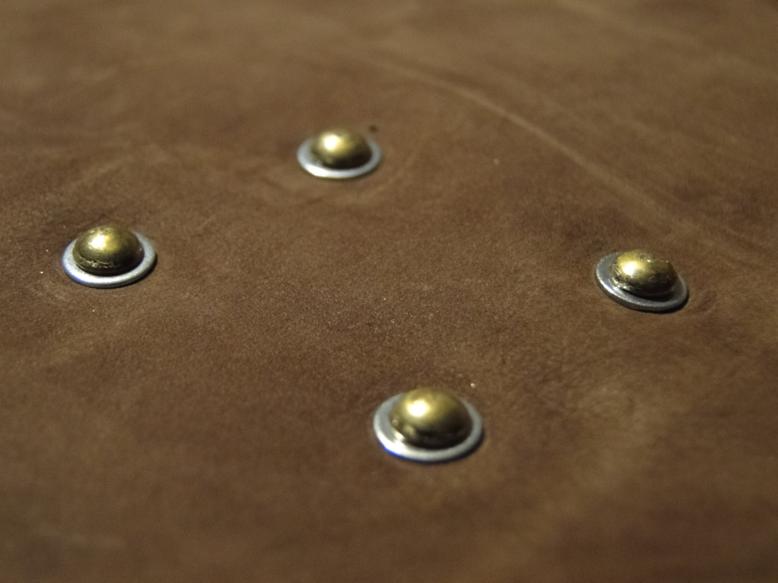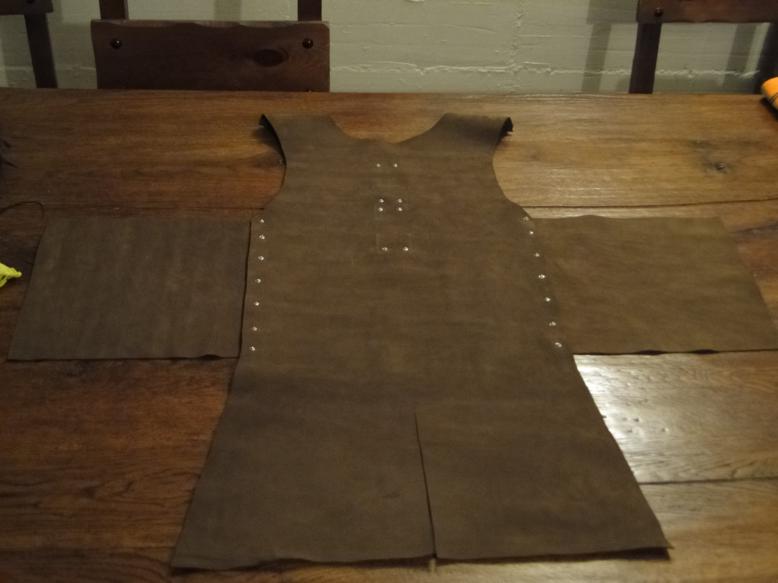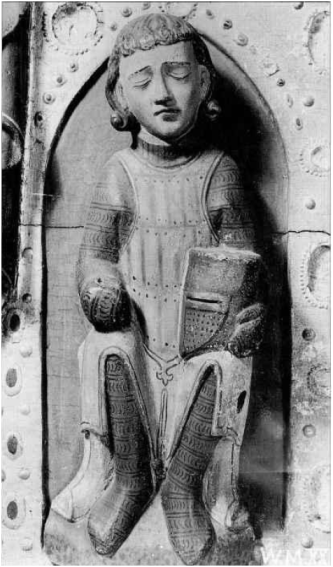| Author |
Message |
Roberto Banfi

|
 Posted: Thu 19 Jul, 2012 4:50 am Post subject: just another Early CoP thread Posted: Thu 19 Jul, 2012 4:50 am Post subject: just another Early CoP thread |
 |
|
based on the well-known St Maurice from Magdeburg (mid-13th Century)...

I'm making a leather "surcoat" reinforced with steel plates (1,5 mm) on the torso
I'm using solid brass rivets and home-made leather washers
pics coming asap 
|
|
   |
 |
Roberto Banfi

|
 Posted: Thu 19 Jul, 2012 6:03 am Post subject: Posted: Thu 19 Jul, 2012 6:03 am Post subject: |
 |
|
a view from the inside, just two plates attached for now (5 x 12 cm)
 Attachment: 75.19 KB Attachment: 75.19 KB

|
|
   |
 |
Roberto Banfi

|
 Posted: Thu 19 Jul, 2012 6:06 am Post subject: Posted: Thu 19 Jul, 2012 6:06 am Post subject: |
 |
|
as seen from the front side, the steel washer was necessary to avoid the rivet head cutting into the leather
 Attachment: 51.92 KB Attachment: 51.92 KB

|
|
   |
 |
Roberto Banfi

|
 Posted: Thu 19 Jul, 2012 6:07 am Post subject: Posted: Thu 19 Jul, 2012 6:07 am Post subject: |
 |
|
still work in progress but you can catch the overall thing
 Attachment: 55.51 KB Attachment: 55.51 KB

|
|
   |
 |
|
Matthew P. Adams
|
 Posted: Fri 20 Jul, 2012 4:07 pm Post subject: Posted: Fri 20 Jul, 2012 4:07 pm Post subject: |
 |
|
Not to undermine your project at all, which is looking very nice by the way!
But I had thought that the plates overlapped? Perhaps not always?
"We do not rise to the level of our expectations. We fall to the level of our training" Archilochus, Greek Soldier, Poet, c. 650 BC
|
|
  |
 |
Roberto Banfi

|
 Posted: Sat 21 Jul, 2012 1:15 am Post subject: Posted: Sat 21 Jul, 2012 1:15 am Post subject: |
 |
|
thanks Matthew
no mining at all, comments and critics are welcome
at the best of my knowledge I have no access to original findings to look the inner side, so I guess it's a matter of speculation
since it's a very early stage of plates usage for armour I thought it would be (perhaps) more accurate a simple side by side assembly
overlapping plates implies they are capable of moving as an articulated piece of armour, this would be far too technological for the second half of 13 C.
this is only my opinion though 
|
|
   |
 |
Romulus Stoica

Location: Hunedoara, Transylvania, Romania Joined: 26 Oct 2006
Posts: 124
|
 Posted: Sat 21 Jul, 2012 1:27 am Post subject: Posted: Sat 21 Jul, 2012 1:27 am Post subject: |
 |
|
Serarch for the book :
Armour from the Battle of Wisby 1361. Vol. I, Vol. II
There you will find a lot of C.O.P.'s with detailed description and images.
|
|
   |
 |
Roberto Banfi

|
 Posted: Sat 21 Jul, 2012 1:35 am Post subject: Posted: Sat 21 Jul, 2012 1:35 am Post subject: |
 |
|
Hi,
Wisby plates are known to me but there about 100 years in the middle
|
|
   |
 |
Roberto Banfi

|
 Posted: Sat 21 Jul, 2012 1:59 am Post subject: Posted: Sat 21 Jul, 2012 1:59 am Post subject: |
 |
|
| Roberto Banfi wrote: | | since it's a very early stage of plates usage for armour I thought it would be (perhaps) more accurate a simple side by side assembly |
in addition this is the "Sleeping Guard" of the Holy Sepulchre, German late 13th Century
I spot three rows of non overlapping rectangular plates with four rivets each
 Attachment: 233.77 KB Attachment: 233.77 KB

|
|
   |
 |
Dan Howard

|
 Posted: Sat 21 Jul, 2012 7:00 am Post subject: Posted: Sat 21 Jul, 2012 7:00 am Post subject: |
 |
|
|
It is very rare for these types of armours to not have overlapping plates. The protective capacity drops considerably if they don't overlap. The sleeping guard is one of the few examples that appear to show non-overlapping plates but there are plenty of reasons why this may not have been the case in reality.
|
|
  |
 |
Roberto Banfi

|
 Posted: Sat 21 Jul, 2012 7:15 am Post subject: Posted: Sat 21 Jul, 2012 7:15 am Post subject: |
 |
|
I can assume that protective capability drops particularly against thrusts since an acute point could find its way into the cloth /leather gaps between metal plates
I am no expert in 15th C. but brigandines aren't made of many small not overlapping plates, are they?
|
|
   |
 |
Roberto Banfi

|
 Posted: Sat 21 Jul, 2012 7:25 am Post subject: Posted: Sat 21 Jul, 2012 7:25 am Post subject: |
 |
|
update... only four plates missing on 2nd and 3rd row; I left a little room for side stitchings for which I was drilling holes in advance
 Attachment: 198.45 KB Attachment: 198.45 KB
[ Download ]
|
|
   |
 |
|
Colt Reeves
|
 Posted: Sat 21 Jul, 2012 8:05 am Post subject: Posted: Sat 21 Jul, 2012 8:05 am Post subject: |
 |
|
| Roberto Banfi wrote: | | I am no expert in 15th C. but brigandines aren't made of many small not overlapping plates, are they? |
They overlap. See here: http://upload.wikimedia.org/wikipedia/commons...iew%29.JPG
"Tears are for the craven, prayers are for the clown.
Halters for the silly neck that cannot keep a crown.
As my loss is grievous, so my hope is small.
For Iron, Cold Iron, must be master of men all..."
-Cold Iron, Rudyard Kipling
|
|
  |
 |
Ben Anbeek
Industry Professional

|
|
   |
 |
|
Reinier van Noort
|
 Posted: Sat 21 Jul, 2012 3:08 pm Post subject: Posted: Sat 21 Jul, 2012 3:08 pm Post subject: |
 |
|
A long time ago, I constructed a CoP based on that sleeping guard statuette, almost exactly like the one the threadposter is making now, only using linen instead of leather (and leaving off the long flaps); when worn the non-overlapping plates still rest against each other, and part of the force of a blow is transferred around the body of the wearer. At least, that is my experience (when worn over a gambeson and maille)
School voor Historische Schermkunsten
www.bruchius.com
|
|
   |
 |
Dan Howard

|
 Posted: Sat 21 Jul, 2012 3:23 pm Post subject: Posted: Sat 21 Jul, 2012 3:23 pm Post subject: |
 |
|
|
Doesn't tell us anything without a comparative analysis. How much better would it have performed if the plates overlapped?
|
|
  |
 |
|
William P
|
 Posted: Sat 21 Jul, 2012 10:41 pm Post subject: Posted: Sat 21 Jul, 2012 10:41 pm Post subject: |
 |
|
ive heard the 'sleeping guard' 'COP' as being described in one book of mine as a reinforced surcoat and one could say that its an exmple of the step BEFORE the full blown coat of plates just as a way of adding something solid to go in front of the rest of the armour
remember that russian kolontars and japanese tatami dou consisted of non overlapping plates within a maile matrix instead id imagine this reinforced surcoat would go over the mail hauberk.
|
|
   |
 |
Roberto Banfi

|
 Posted: Sun 22 Jul, 2012 2:40 am Post subject: Posted: Sun 22 Jul, 2012 2:40 am Post subject: |
 |
|
thanks  I'm gonna keep that in mind I'm gonna keep that in mind
|
|
   |
 |
|
Jojo Zerach
|
 Posted: Sun 22 Jul, 2012 9:27 am Post subject: Posted: Sun 22 Jul, 2012 9:27 am Post subject: |
 |
|
| Roberto Banfi wrote: | Hi,
Wisby plates are known to me but there about 100 years in the middle |
Although the Wisby coat-of-plates were being used in the 1360's, they probably represent armour technology of the 1280-1320 period. By 1340, effigies and art commonly show more developed CoP designs which cover the hips and have a waisted profile.
(Remember the Wisby armour was being used by a desperate, poorly equipped militia in the armour-backwater of Europe, not a good place to look for the latest armour designs.)
There is nothing technologically complex about overlapping plates, regardless of the time period. I would assume it was done from the very beginning.
|
|
  |
 |
Roberto Banfi

|
 Posted: Sun 22 Jul, 2012 1:43 pm Post subject: Posted: Sun 22 Jul, 2012 1:43 pm Post subject: |
 |
|
| Jojo Zerach wrote: |
Although the Wisby coat-of-plates were being used in the 1360's, they probably represent armour technology of the 1280-1320 period. By 1340, effigies and art commonly show more developed CoP designs which cover the hips and have a waisted profile.
(Remember the Wisby armour was being used by a desperate, poorly equipped militia in the armour-backwater of Europe, not a good place to look for the latest armour designs.)
There is nothing technologically complex about overlapping plates, regardless of the time period. I would assume it was done from the very beginning. |
I doubt that Wisby-style CoPs were worn by warriors during for example the Battle of Campaldino (Italy, Tuscany - 1290) or Courtrai (Belgium, 1302) even if some elbow or knee cops were quite developed for the time; I can accept that a battlefield boasts a decade or two of weapons and armours but without findings or adequate documentation I stick to my point.
I love Wisby harness BTW 
|
|
   |
 |
|
|

